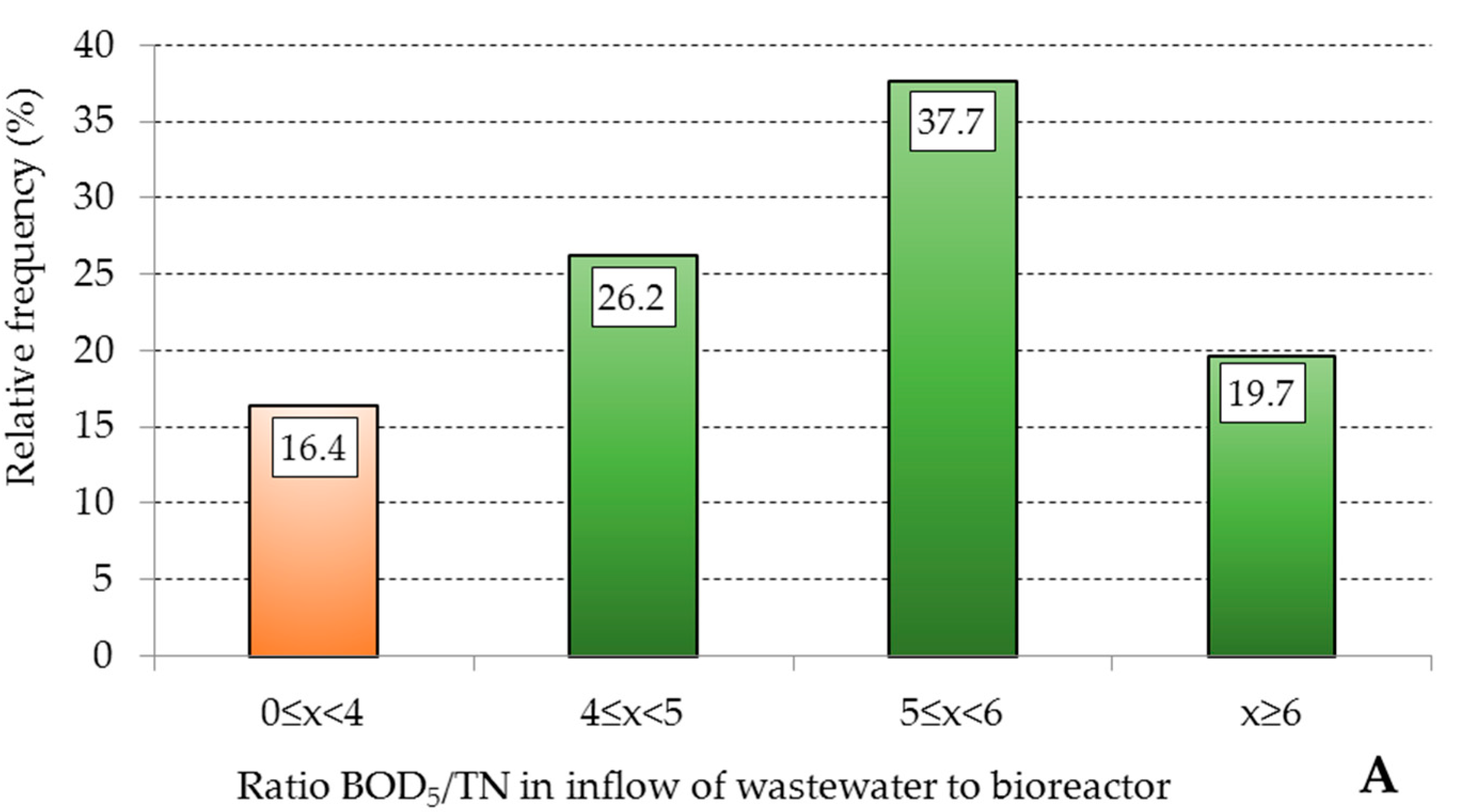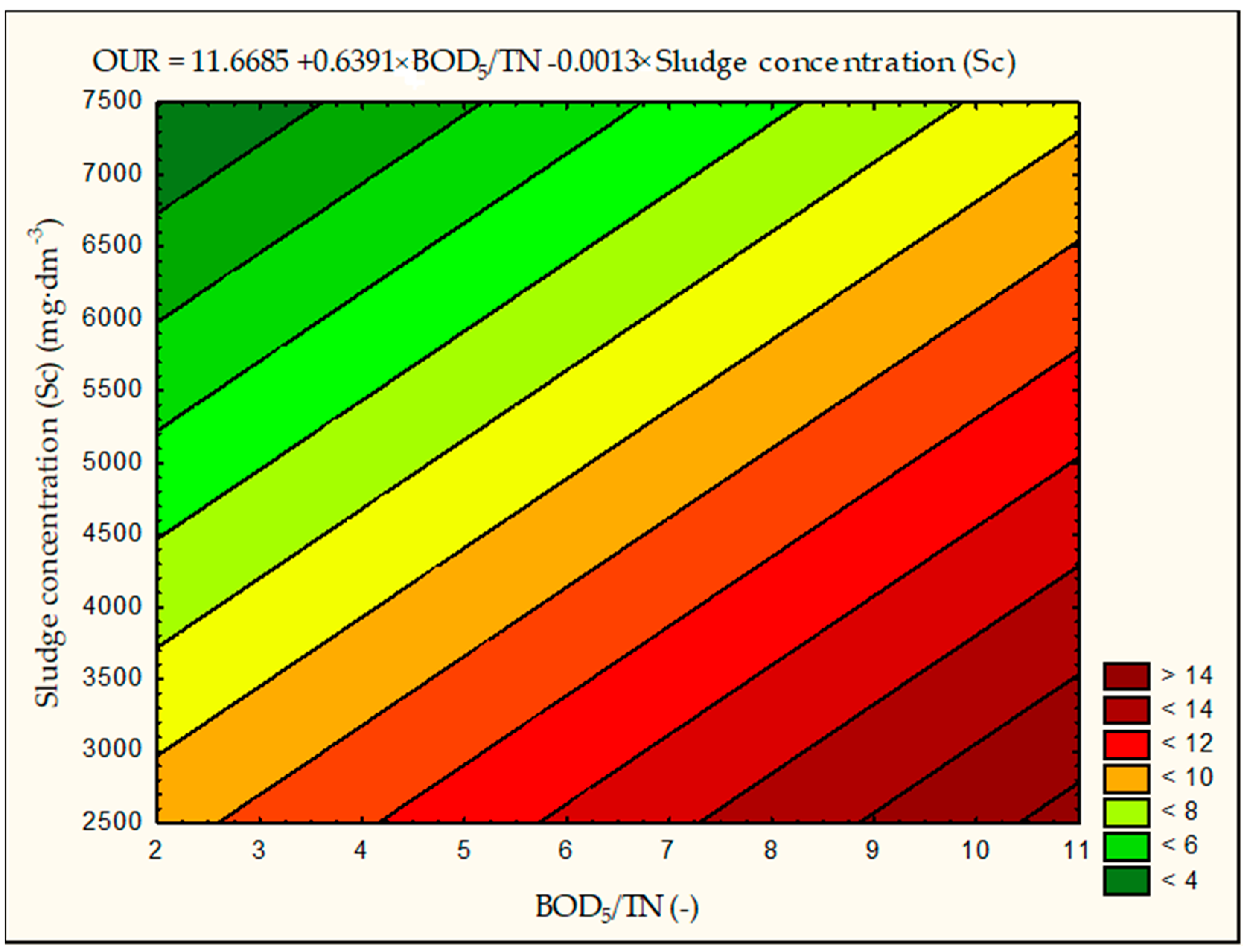The Impact of Selected Parameters on the Condition of Activated Sludge in a Biologic Reactor in the Treatment Plant in Nowy Targ, Poland
Abstract
:1. Introduction
2. Materials and Methods
2.1. Characteristics of the Sewage System and Wastewater Treatment Plant
2.2. Analytical and Statistical Methods
- −
- Collection of a sample of activated sludge from the biologic reactor;
- −
- Filling of a measuring cylinder (volume: 3 dm3) followed by aeration (3 h);
- −
- After 3 h of aeration, addition of wastewater (constituting medium for microorganisms) to the measuring cylinder, after this time, the oxygenation level was 8 (±0.3) mgO2·dm−3;
- −
- Determination of a dry matter content of sediments in the wastewater mixture;
- −
- Filling of a vessel (equipped with an oxygen probe) with wastewater containing biomass;
- −
- Recording of the initial value of dissolved oxygen (TR);
- −
- Measurement of oxygen concentration within 10 min—at 1 min interval;
- −
- Based on the test of a sample with activated sludge (biomass), the rate of PPT oxygen uptake was determined with the use of Formula (1). It was presented in the test stand in Figure 2.
3. Results and Discussion
3.1. Characteristics of Wastewater Flowing into the Biologic Reactor
3.2. Impact of BOD5/TN and BOD5/TP for OUR
3.3. Impact of Sludge Concentration (Sc) in the Biologic Reactor on OUR
3.4. Partial Correlation for OUR—Sludge Concentration and BOD5/TN and BOD5/TP Ratio
4. Conclusions
Author Contributions
Funding
Acknowledgments
Conflicts of Interest
References
- Trikoilidou, E.; Samiotis, G.; Bellos, D.; Amanatidou, E. Sustainable operation of a biological wastewater treatment plant. IOP Conf. Ser. Mater. Sci. Eng. 2016, 161, 012093. [Google Scholar] [CrossRef]
- Mailler, R.; Gasperi, J.; Coquet, Y.; Buleté, A.; Vulliet, E.; Deshayes, S.; Zedek, S.; Mirande-bret, C. Science of the Total Environment. Removal of a wide range of emerging pollutants from wastewater treatment plant discharges by micro-grain activated carbon in fluidized bed as tertiary treatment at large pilot scale. Sci. Total Environ. 2016, 542, 983–996. [Google Scholar] [CrossRef] [PubMed] [Green Version]
- Karamus, Ł. Wastewater Treatment Plants and Their Exploitation; Wydawnictwo Kabe: Krosno, Poland, 2018; p. 232. ISBN 978-83-65382-19-1. (In Polish) [Google Scholar]
- Shobhan, M.; Poornesh; Reethupoorna, M.B.; Mustafa, R. A review on working, treatment and performance evaluation of sewage treatment plant. J. Eng. Res. Appl. 2019, 9, 41–49. [Google Scholar]
- Zhang, J.; Ma, L. Environmental sustainability assessment of a new sewage treatment plant in china based on infrastructure construction and operation phases energy analysis. Water 2020, 12, 484. [Google Scholar] [CrossRef] [Green Version]
- Krzanowski, S.; Wałęga, A.; Paśmionka, I. Treatment of sewage from selected food manufacturing plants. Infrastruct. Ecol. Rural Areas 2008, 1, 89. (In Polish) [Google Scholar]
- Takács, I. Experiments in Activated Sludge Modeling. Ph.D. Thesis, Ghent University, Ghent, Belgium, 2008; p. 267. [Google Scholar]
- Vaiopoulou, E.; Gikas, P. Effects of chromium on activated sludge and on the performance of wastewater treatment plants: A review. Water Res. 2012, 46, 549–570. [Google Scholar] [CrossRef]
- Masłoń, A. The dynamics of wastewater flow to the wastewater treatment plant in the aspect of the sequencing batch reactors functioning. Instal 2017, 10, 57–62. (In Polish) [Google Scholar]
- Bugajski, P.; Nowobilska–Majewska, E. A weibull analysis of the reliability of a wastewater treatment plant in Nowy Targ, Poland. Annu. Set Environ. Prot. 2019, 21, 825–840. [Google Scholar]
- De Bénédittis, J. Mesurage de L’infiltration et de L’exfiltration Dans les Réseaux D’assainissement; Le Grade de Docteur; INSA de Lyon: Villeurbanne, France, 2004. (In French) [Google Scholar]
- Butler, D.; Davies, J.W. Urban Drainage, 3rd ed.; Spon Press an Imprint of Taylor & Francis: London, UK; New York, NY, USA, 2011. [Google Scholar]
- Cieślak, O.; Pawełek, J. Dopływ wód obcych do kanalizacji sanitarnej na przykładzie gminy Mézos we Francji. Instal 2014, 7–8, 90–95. (In Polish) [Google Scholar]
- Bugajski, P.; Pawełek, J.; Kurek, K. Concentrations of organic and biogenic pollutants in domestic wastewater after mechanical treatment in the aspect of biological reactor design. Infrastruct. Ecol. Rural Areas 2017, IV/3, 1811–1822. [Google Scholar]
- Arnold, E.; Bohm, B.; Wilderem, P.A. Application of activated sludge and biofilm sequencing bath reactor technology to treat reject water from sludge dewatering systems: A comparison. Water Sci. Technol. 2000, 41, 115–122. [Google Scholar] [CrossRef]
- Kosińska, K. Biochemical tests as a tool for the assessment of biological treatment process. Ochr. Środowiska I Zasobów Nat. 2005, 28, 25–40. (In Polish) [Google Scholar]
- Krzanowski, S.; Wałęga, A. the effect of physicochemical properties of sugar industry wastes on activity of activated sludge and efficiency of nitrogen compound removal. Infrastruct. Ecol. Rural Areas 2007, 1, 163–178. (In Polish) [Google Scholar]
- Makuch, A. Biological removal of nitrogen compounds from sulfonamide containing wastewater. Ph.D. Thesis, Politechnika Gdańska, Gdańsk, Poland, 2009; p. 170. (In Polish). [Google Scholar]
- Głodniok, M. The use respirometric and microscopic analysis to control the physiological state of activated sludge. J. Ecol. Health. 2012, 16, 164–168. (In Polish) [Google Scholar]
- Polish Standards According Limits for Discharged Sewage and Environmental Protection from November 18 2014 (No 2014 Item 1800). Available online: http://prawo.sejm.gov.pl/isap.nsf/download.xsp/WDU20140001800/O/D20141800.pdf (accessed on 16 December 2014). (In Polish)
- Kristensen, G.H.; Jorgensen, P.E.; Henze, M. Characterization of functional microorganism groups and substrate in activated sludge and wastewater by AUR, NUR and OUR. Water Sci. Technol. 1992, 25, 43–57. [Google Scholar] [CrossRef]
- Drzewicki, A. Biotic index of active sludge in practical monitoring of sewage treatment. Gaz Woda I Tech. Sanit. 2010, 7–8, 42–44. (In Polish) [Google Scholar]
- Dymaczewski, Z. Poradnik Eksploatatora Oczyszczalni Ścieków; PZITS o/Wielkopolski: Poznań, Poland, 2011. (In Polish) [Google Scholar]
- Nowobilska–Majewska, E.; Bugajski, P. Influence of the amount of inflowing wastewater on concentrations of pollutions contained in the wastewater in the Nowy Targ sewerage system. Ecol. Environ. Eng. 2018. [Google Scholar] [CrossRef] [Green Version]
- Nowobilska–Majewska, E.; Bugajski, P. The Analysis of the Amount of Pollutants in Wastewater after Mechanical Treatment in the Aspect of their Susceptibility to Biodegradation in the Treatment Plant in Nowy Targ. J. Ecol. Eng. 2019, 20, 135–143. [Google Scholar] [CrossRef]
- Zdebik, D.; Głodniok, M. The results of studies of wastewater susceptibility on biological decomposition on an example of wastewater treatment plant operated in the sequential-flow technology. Zesz. Nauk. Uniw. Zielonogórski Inżynieria Środowiska 2011, 141, 53–64. (In Polish) [Google Scholar]
- Młyńska, A.; Chmielowski, K.; Młyński, D. Analysis of sewage quality changes during treatment processes at the wastewater treatment plant in Przemyśl. Ecol. Eng. 2017, 18, 18–26. (In Polish) [Google Scholar]
- Wawrzynek, J. Methods of Description and Statistical Inference; Wydawnictwo Akademii Ekonomicznej im; Oskara Langego We Wrocławiu: Wrocław, Poland, 2007; p. 37. (In Polish) [Google Scholar]
- Łomotowski, J.; Szpindor, A. Modern Wastewater Treatment Systems; Wydawnictwo Arkady: Warszawa, Poland, 1999. (In Polish) [Google Scholar]
- Sadecka, Z. Fundamentals of Biological Wastewater Treatment; Wydawnictwo Seidel-Przy Wecki: Warsaw, Poland, 2010. (In Polish) [Google Scholar]
- Ganigué, R.; Volcke, E.I.P.; Puig, S.; Balaguer, M.D.; Colprim, J. Impact of influent characteristics on a partial nitritation SBR treating high nitrogen loaded wastewater. Bioresour. Technol. 2012, 111, 62–69. [Google Scholar] [CrossRef] [PubMed]
- Henze, M.; Harremoes, P.; Jansen, J.; Arvin, E. Wastewater Treatment: Biological and Chemical Processes; Wydawnictwo Politechniki Świętokrzyskiej: Kielce, Poland, 2002. (In Polish) [Google Scholar]
- Stanisz, A. An Affordable Statistic Course with the Use of STATISTICA PL on the Examples of Tom 1 Medicine. Basic Statistics; Wydawnictwo StatSoft Polska Sp. z o.o.: Kraków, Poland, 2006; p. 532. (In Polish) [Google Scholar]
- Sui, Q.; Yan, P.; Cao, X.; Lu, S.; Zhao, W.; Chen, M. Biodegradation of bezafibrate by the activated sludge under aerobiccondition: Effect of initial concentration, temperature and pH. Emerg. Contam. 2016, 2, 173–177. [Google Scholar] [CrossRef] [Green Version]
- Moretti, C.J.; Das, D.; Kistner, B.T.; Gullicks, H.; Hung, Y.T. Activated Sludge and Other Aerobic Suspended Culture Processes. Water 2011, 3, 806–818. [Google Scholar] [CrossRef]









| Parameters | Statistics | |||||
|---|---|---|---|---|---|---|
| Average mg·dm−3 | Median mg·dm−3 | Min. mg·dm−3 | Max. mg·dm−3 | Deviation Stand. mg·dm−3 | Coefficient of Variation % | |
| BOD5 | 400.5 | 409.4 | 222.5 | 634.6 | 101.1 | 25 (average) |
| TN | 80.6 | 80.5 | 44.1 | 162.5 | 22.4 | 28 (average) |
| TP | 12.5 | 12.0 | 7.1 | 22.8 | 3.8 | 30 (average) |
| Sludge concentration MLSS (Sc) | 4446.2 | 4460.0 | 2930.0 | 6900.0 | 760.1 | 17 (low) |
| Statistics | Number of Measurements | Partial Correlation Coefficient | Coefficient of Determination | Variable Standard Deviation | Arithmetic Mean of the Variable | Value of t-Statistic | Value of Test A = 0.05 |
|---|---|---|---|---|---|---|---|
| Designation correlation | N | Rc | R2 | Sd | SR | t | tαkr |
| BOD5/TN | 61 | 0.50 | 0.21 | 1.2 | 5.1 | 4.22 | 0.000087 |
| OUR | 1.9 | 9.0 | |||||
| Sludge concentration | 61 | −0.60 | 0.21 | 760.1 | 4446.2 | −5.66 | 0.000000 |
| OUR | 1.9 | 9.0 |
| Statistics | Number of Measurements | Partial Correlation Coefficient | Coefficient of Determination | Variable Standard Deviation | Arithmetic Mean of the Variable | Value of t-Statistic | Value of Test A = 0.05 |
|---|---|---|---|---|---|---|---|
| Designation correlation | N | Rc | R2 | Sd | SR | t | tαkr |
| BOD5/TP | 61 | 0.31 | 0.20 | 8.0 | 33.5 | 2.50 | 0.015409 |
| OUR | 1.9 | 9.0 | |||||
| Sludge concentration | 61 | −0.61 | 0.20 | 760.1 | 4446.2 | −5.88 | 0.000000 |
| OUR | 1.9 | 9.0 |
© 2020 by the authors. Licensee MDPI, Basel, Switzerland. This article is an open access article distributed under the terms and conditions of the Creative Commons Attribution (CC BY) license (http://creativecommons.org/licenses/by/4.0/).
Share and Cite
Nowobilska-Majewska, E.; Bugajski, P. The Impact of Selected Parameters on the Condition of Activated Sludge in a Biologic Reactor in the Treatment Plant in Nowy Targ, Poland. Water 2020, 12, 2657. https://doi.org/10.3390/w12102657
Nowobilska-Majewska E, Bugajski P. The Impact of Selected Parameters on the Condition of Activated Sludge in a Biologic Reactor in the Treatment Plant in Nowy Targ, Poland. Water. 2020; 12(10):2657. https://doi.org/10.3390/w12102657
Chicago/Turabian StyleNowobilska-Majewska, Elwira, and Piotr Bugajski. 2020. "The Impact of Selected Parameters on the Condition of Activated Sludge in a Biologic Reactor in the Treatment Plant in Nowy Targ, Poland" Water 12, no. 10: 2657. https://doi.org/10.3390/w12102657
APA StyleNowobilska-Majewska, E., & Bugajski, P. (2020). The Impact of Selected Parameters on the Condition of Activated Sludge in a Biologic Reactor in the Treatment Plant in Nowy Targ, Poland. Water, 12(10), 2657. https://doi.org/10.3390/w12102657






